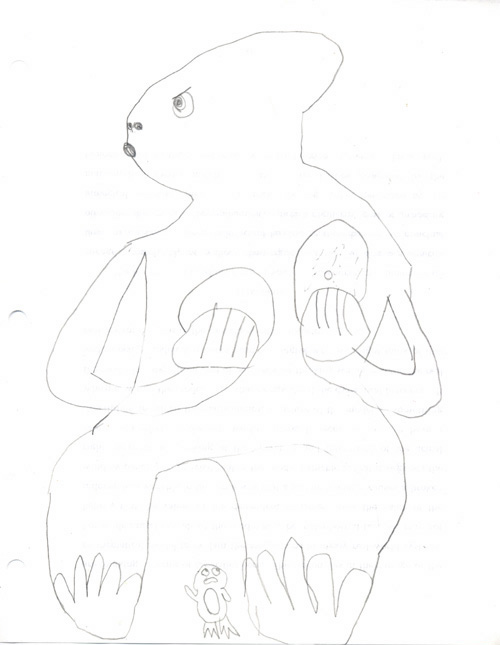 There’s a lot going on this week and next that captures the interest and imagination of the Free-Ride offspring. They’ve been thinking about animals that live in places we do not (like the briny seas), noticing the critters that live in our neighborhood, contemplating the ways a domestic animal might interact with our backyard ecosystem, and even musing on human nature.
There’s a lot going on this week and next that captures the interest and imagination of the Free-Ride offspring. They’ve been thinking about animals that live in places we do not (like the briny seas), noticing the critters that live in our neighborhood, contemplating the ways a domestic animal might interact with our backyard ecosystem, and even musing on human nature.
But what you’ll really want to know is why does this penguin look so scared? Read on and find out.
The backyard species census.
The sprogs and I are going to be participating in the First Annual Blogger Bioblitz, an event to celebrate National Wildlife Week, which starts Saturday. We’ll be out in the yard noting the birds, bugs, and other critters in our immediate vicinity. There’s quite a variety that we’ve noticed without making concerted efforts to observe all there is to observe, and we’ll be doing what we can to identify the critters we observe. We’ll report on that in this space next week.
I don’t think we’ll be tracking the plant kingdom members, given the ongoing Free-Ride parental unit campaign to rid our yard of weeds. (Is it worth making careful identifications of the plants you’re going to uproot, chop into little pieces, and compost?)
Of course, Sunday is Earth Day, so we’ll likely be finding some outdoorsy activities to celebrate it.
What would happen if our backyard ecosystem included a chicken?
We’re thinking about this, especially after I discovered a colleague has been keeping a couple of Rhode Island Reds in his backyard. The sprogs view a chicken as a potential pet. I’m attracted to the idea because a chicken can be an effective snail and slug gobbler — and we have a huge snail and slug population. Also, a chicken will gladly nibble weeds. However, chickens may not be great at distinguishing between weeds and the plants we want to be growing. (Would Skinnerian conditioning help with this?) This makes me wonder if a chicken might have an impact on the population of “good bugs” in our backyard, too.
The main issue that made a backyard chicken seem impractical was the number of neighborhood cats that wander through our yard, but my colleague assures me that cats elect not to mess with a full-grown Rhode Island Red. Raccoons might be another matter, but as they’re nocturnal, keeping the chickens in a coop at night might do the job.
Any of you with chicken experience who would like to give us advice on this should do so.
Megavertebrate week!
Deep Sea News declared Megavertebrate Week, and the sprogs celebrated by drawing some pictures of large-ish vertebrates. Actually, I requested that they each draw me a picture of “charismatic megafauna” — big animals that humans find cute or cool.
The elder Free-Ride offspring made with the pinipeds:

A fine choice. I can personally attest to the charisma of seals and sea lions, having recently toured The Marine Mammal Center in Sausalito and gotten a glimpse into their rescue and rehabilitation operations. Those pups are really cute. And, for babies, they’re also really big.
The younger Free-Ride offspring gave me a twofer:

Penguins are charismatic. Gorillas are charismatic. But, as this picture shows, the power of that charisma may depend on the circumstances. A gorilla may be more appealing on a nature program than, say, standing right above you.
 A book we like a lot for little kids about penguins and their lifecycle is Penguin (Watch me grow). It has a feel that’s somewhere between a story book and a science book, which makes it a nice way to dip a kid’s toe into the water on science.
A book we like a lot for little kids about penguins and their lifecycle is Penguin (Watch me grow). It has a feel that’s somewhere between a story book and a science book, which makes it a nice way to dip a kid’s toe into the water on science.
The book is silent, however, on relations between penguins and gorillas.
Human nature.
Younger offspring was indignant when pushed off a bouncy-bike ride at the playground by another child yesterday. “He didn’t ask for a turn or anything, just pushed me off!” I returned to the scene of the crime with younger offspring and told the kid, “We don’t push other kids off the play equipment. This playground is for everyone to share, but you should ask for a turn, not just push.”
He fled the scene, clearly surprised to be called out for the pushing. Then younger offspring and I had a chat wherein we decided that part of becoming a big kid is behaving the way you’re supposed to even if you don’t think any grown-ups are watching.
There may be some grown-ups who could stand to think about that for awhile.

I saw a letter in this month’s Countryside magazine involving the training of chickens to return to the hen house for feeding in the evening, so that may raccoon-proof your chickens. Many people just use moveable hen houses. You may want to combine the two. As a bonus I can certainly provide the oyster shells (for good thick shells) and I’d be happy to take the would be poule au pot off your hands at the end of it all.
I’d probably start with bees, but that’s just me.
yer a good ma, dr free-ride.
My chicken experiences go back 50 years, but I have serious doubts if chickens have done any real evolution since then.
Yes, chickens will eat any insect, grub, or slug they can find. I never saw them doing much plant eating, and they did wander the vegetable garden.
Be warned that chickens are about as dumb and stupid as most vegetables. You can’t “teach” them anything. Also be warned about how many you get; the more you have, the more evidence you’ll see of the pecking order, and that can get pretty gruesome.
With cats already in the neighborhood, that means you have to avoid getting any immature birds — the cats will take out anything that doesn’t intimidate them. Maybe you could get a couple mature layers from a farm. The eggs from free-run birds really do look and taste better than others.
We keep chickens in a low key, free range kinda way. It’s very relaxing to watch chickens wander across the lawn. I love the sound they make. Cats shouldn’t be a problem for a full grown bird but racoons and skunks (and depending where you live foxes, coyotes, hawks, fishers, weasels, owls and dogs) are all predators. Racoons are the worst in my experience.
Chickens scratch. They cannot be taught to distinguish between lettuce and thistles (actually they’ll leave the thistles alone and go after the lettuce) without use of lethal force. They can dig up lots of tenderly guarded plants as they look for tasty grubs. It’s easiest to either fence them out of your garden or fence the chickens in. I don’t think they’d eat too many good bugs, but we’ve seen them kill and eat mice, frogs and small snakes….
You might want to consider a duck. They’ll eat just as much bok choi as a chicken but they don’t scratch.
I second the good ma.
I second the duck idea. (I hear ducks and guinea fowl eat more slugs than chickens but I’ve never tried.) Duck eggs are great both fried and as baking ingredients. And I’d be happy to take care of the gavage part.